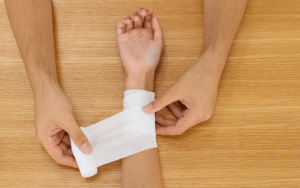
 Cumulative Trauma Injury, also known as Cumulative Trauma Disorders (CTDs), are becoming more prevalent in the workplace all over the United States. In fact, CTDs account for more than 50% of all occupational illnesses in the United States, according to the Bureau of Labor Statistics. CTDs include a wide variety of injuries, all of which affect muscles, tendons, and ligament structures. The most common CTD found in the workplace just so happens to be carpal tunnel syndrome, which is accounted for the greatest number of days away from work.
Cumulative Trauma Injury, also known as Cumulative Trauma Disorders (CTDs), are becoming more prevalent in the workplace all over the United States. In fact, CTDs account for more than 50% of all occupational illnesses in the United States, according to the Bureau of Labor Statistics. CTDs include a wide variety of injuries, all of which affect muscles, tendons, and ligament structures. The most common CTD found in the workplace just so happens to be carpal tunnel syndrome, which is accounted for the greatest number of days away from work.
Imagine yourself sitting in an office setting or standing in a labor setting, and repeating the same type of motions with your hands all day long. This is what typically causes most of these conditions, which are brought on by repetitive motion and overuse; more specifically, many people who work on assembly lines or at computers all day could expect to obtain one of these injuries.
Sometimes, the trauma happens because there is inexperience of the job tasks, improper supervision by an employer to the point where bad habits occur, a belief that more force on the muscles gets the job done, or poorly designed equipment requires more effort to complete a task. All of these factors work together and are considered when an employee is injured on-the-job for a CTD.
How do Fixed Working Postures Play a Part?
Muscles in our body develop “trigger points”, which are due to the chronic stress state of a muscle. Workers who work on a line may find these common conditions within their duties throughout the day. Workers on a line may also experience accumulating static loading of the neck and shoulder muscles, which adds a strain to these muscles and enables areas of primary stress.
Examples of CTDs
Here are some of the most common disorders that are seen in office settings. They are all painful and sometimes crippling disorders that develop gradually over periods of weeks, months, or even years.
- Carpal Tunnel Syndrome: This is a painful condition of the hand and fingers that is caused by compression of a major nerve where it passes over the carpal bones through a passage at the front of the wrist. It could be caused by repetitive motions or fluid retention.
- Tendinitis: This is an inflammation, swelling, or irritation of a tendon. It develops when the tendon is repeatedly tensed from overuse.
- Low Back Disorders: This can include pulled or strained muscles, ligaments, tendons, or ruptured disks. When it comes to these disorders, causes may include poor posture or improper lifting techniques.
- Bursitis: This is the inflammation of the connective tissue that surrounds the joint. It typically includes the shoulder.
- Epicondylitis: This is elbow pain that is associated with extreme rotation of the forearm and bending of a wrist.
Cervical Radiculopathy: This is a compression of the nerve roots in the person’s neck.
Treatment
The first, best treatment for CTDs is usually rest from the activities that caused the problem in the first place. This could mean time away from the work at hand or a general, overall change in work practices. As soon as symptoms of a CTD are recognized, it is very important to speak with a doctor.
This is for documentation purposes and to catch the CTD early so treatment can be started. You may be sent to a neurologist or to therapy depending on what tests or treatment you need. Treatments may include wrist splints, cold or hot baths, anti-inflammatory medications, steroid injections, physical therapy, or even surgery in advanced cases (NJDH).
Workers’ Compensation
If you have sustained a CTD in the workplace, you may be entitled to certain workers’ compensation benefits. These benefits may include medical treatment, temporary compensation while unable to work, permanent disability, or partial disability.
You can contact RAWA Law Group today for a free consultation. Get back on track in your lifestyle and receive the compensation that you deserve from your injury.





